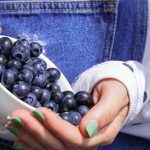How blue and purple plant pigments battle cancer, heart disease, and stroke
 (NaturalHealth365) The ketogenic diet, the “Paleo” diet, the Mediterranean diet, the DASH diet – it seems there is no end to the head-spinning variety of diets, all touted to support well-being and longevity. However, regardless of which diet they favor, scientists, nutritionists, conventionally trained physicians, and holistic doctors generally acknowledge that multiple studies link higher intakes of “colorful” foods (mainly fruits and vegetables) with lower rates of life-threatening cancers and heart disease.
(NaturalHealth365) The ketogenic diet, the “Paleo” diet, the Mediterranean diet, the DASH diet – it seems there is no end to the head-spinning variety of diets, all touted to support well-being and longevity. However, regardless of which diet they favor, scientists, nutritionists, conventionally trained physicians, and holistic doctors generally acknowledge that multiple studies link higher intakes of “colorful” foods (mainly fruits and vegetables) with lower rates of life-threatening cancers and heart disease.
It turns out that the natural plant pigments in fruits and vegetables contribute more than an attractive “pop” of color. Multiple studies and reviews attest that plant pigments have antioxidant and anti-inflammatory capacities that can help sustain health and even prevent cancer. In addition, according to a new study published in the peer-reviewed Journal of Nutrition, a group of pigments known as anthocyanins is linked with lower rates of ischemic stroke. Read on to discover what’s behind their new place in the scientific spotlight.
Antioxidant benefits found in hundreds of varieties of THIS natural plant compound
Simply put, anthocyanins are natural plant compounds that contribute to red, orange, violet, and blue coloration. They can be found in purple grapes, dark cherries, and blueberries – and in less obvious foods such as black beans, Russet potatoes, and red onions.
And when it comes to studying anthocyanins, researchers have their work cut out for them. Recent reviews have revealed over 500 different types, with delphinidin, cyanidin, and pelargonidin among the most significant. In addition to appearing naturally in many “superfoods,” anthocyanins are currently used in the food industry instead of artificial synthetic colorants.
Anthocyanins help ward off breast cancer
The number one killer of female cancer patients, breast cancer, claimed the lives of over 42,000 Americans in 2020 (the last year for which statistics were available). While the causes of cancer can be complex, scientists say that roughly 35 percent of all cancer-related mortality is dependent on lifestyle – meaning that diet can play an important role.
It appears that anthocyanins’ antioxidant and anti-inflammatory qualities can pay off in anticancer health dividends. In a review published in 2022 in Nutrition Research, the authors reported: “Managing inflammation and reducing amounts of dangerous free radicals through antioxidant-rich fruits and vegetables can be a strategy to prevent the onset of breast cancer.”
And, it is not only breast cancer risk that may be lowered. A recent study published in Food Research International shows that higher intakes of dietary anthocyanins are associated with a lower rate of colorectal cancer.
Anthocyanins target cancer cells through multiple mechanisms
While human studies are limited, cell and animal studies have illustrated the anticancer effects of anthocyanins. Studies have suggested that these beneficial compounds help to inhibit matrix metalloproteinases, enzymes that make it easier for cancer to spread. They also suppress cancer cell growth and even encourage apoptosis, the pre-programmed “suicide” of cancer cells.
In addition, anthocyanins increase the activity of natural detoxification enzymes, such as glutathione and superoxide dismutase, and help to discourage the growth of blood vessels that carry life-sustaining oxygen to tumors. Of course, many of these studies used highly concentrated amounts of anthocyanins. Ongoing research focuses on making anthocyanins more biologically available – in other words, delivering them in such a way that the body can access their full benefits.
Protective effects for the heart and brain
Studies show that anthocyanins can increase flow-mediated dilation, the ability of blood vessels to widen, and promote efficient circulation. In one twelve-week study published in the European Journal of Nutrition, older adults with mild to moderate dementia were given six ounces of cherry juice a day. This intervention appeared to improve verbal fluency, cognition, and long-term memory and significantly lowered systolic and diastolic blood pressure.
In a recent review in Frontiers in Pharmacology, researchers found that higher intake of anthocyanins substantially lowered the risk of heart attack and heart disease-related death in young and middle-aged women. The research also suggested that a diet rich in anthocyanins can lower LDL cholesterol and have beneficial antiobesity effects.
In addition to dark cherries, black beans, and purple grapes, other good sources of dietary anthocyanins include mulberries, elderberries, and blue corn. And don’t forget lustrous, blue-black eggplants! For maximum benefit, eat organic fruit and vegetables to avoid unwanted chemicals and, of course, be sure to wash your food well before eating.
While scientists aren’t claiming that dietary natural plant pigments can treat or cure cancer and other chronic diseases, the latest cutting-edge research suggests that a diet high in anthocyanins can help prevent them. In the long run, this proves just as valuable. The takeaway? It makes good sense to “eat the rainbow!” where a “jackpot” of health benefits awaits.
Sources for this article include:
Sciencedirect.com
Sciencedirect.com
MDPI.com
NIH.gov
Healthline.com
NIH.gov



